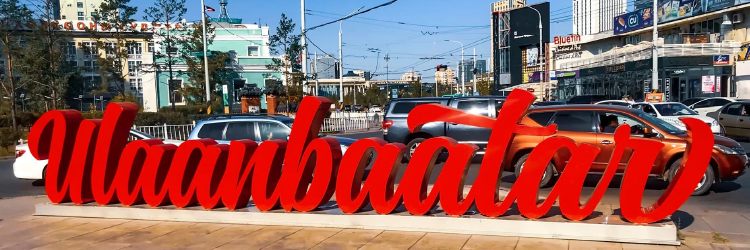When people think of Mongolia, they often think of yurts and people with birds of prey riding ponies across the steppe rather than smart technologies. But in Ulaanbaatar, the Mongolian capital, digitization has also long since arrived in people’s lives. As part of the Sustainability and Mobility in the Context of Smart Cities (SuMoCoS) project supported by the German Federal Ministry of Education and Research, we visited Mongolia and talked about opportunities, possibilities and technologies.
Mongolia and the city of Ulaanbaatar
Mongolia is four times the size of Germany. But it only has around 3.1 million inhabitants. The mountains of the Gorchi-Terelj National Park rise slowly to the north-east of the city, with the sacred mountain Bogd Khan Uul to the south. Logging and hunting were already prohibited here in the 12th century, and subsequent dynasties also protected the area, which is why it is considered the oldest nature park in the world. Today, Bogd Khan Uul is a UNESCO biosphere reserve.
On the other hand, mining is a very important economic sector in Mongolia, especially coal and copper. And that has a negative impact on people’s lives. Half of the population lives in the capital Ulaanbaatar, which lies at the foot of Bogd Khan Uul. Ulaanbaatar, like so many cities sandwiched between mountains, struggles with emissions from cars and industrial fumes. A brown cloud of smog almost always hangs over the city. It’s particularly bad in winter. Then, when the nomads, who still make up a third of the total population, set up their yurts on the outskirts of the city. Because they heat them with old coal stoves. They are not connected to the city’s electricity grid. Then there are the coal-fired power plants, which generate most of the electricity.
Smart technologies for a better climate in Mongolia?
The SuMoCoS (International Conference on Sustainability and Mobility in the Context of Smart Cities) project aims to strengthen international scientific cooperation in the field of smart cities between Germany, Mongolia and Uzbekistan. The cooperation between the project partners should help to understand and address the theoretical and practical challenges of smart city projects in Central Asia (including Mongolia). In Mongolia, one of the main objectives is to reduce pollution and improve mobility.

erminas participated in the conference as a business partner and reported first-hand on how industrial IoT projects can be successfully implemented using simple means. Retrofitting is an important topic due to the stock of old machines, which are often purchased second-hand from other countries. Higher efficiency can significantly reduce both energy consumption and environmental pollution. erminas has shown concrete examples of how the technologies can be used to meet the challenges in Mongolia.
At the panel discussion on “Potential of Smart City Approaches in Mongolia”, erminas CEO Hilmar Bunjes gave an insight into the topic from an industrial perspective. Together with Prof. Dr. Andreas Winter (University of Oldenburg), Acad. Avid Budeebazar (Mongolian Academy of Sciences), Mr. Khaliunbat Myagmarjav (Deputy Governor of the Capital city in charge on Innovation and Technology, Governor’s Office of the Capital City) and Dr. Odgerel Ulziikhutag (Senior Officer at Policy and Planning Department, Ministry of Road and Transport Development), ideas and challenges from the panel and the audience were presented and discussed.
In addition to the conference, the visit to Mongolia was accompanied by a program organized by the Mongolian Ministry of Road and Transport Development. In addition to a visit to the ministry itself, the German delegation was also able to visit the wind farm near Ulaanbaatar and the new Chinggis Khaan International Airport. The trip was rounded off with a visit to the German ambassador Jörn Rosenberg for a joint discussion.
Further discussions and collaboration between the cooperation partners were agreed for the future, as well as a loosely planned meeting in 2021 or 2022. For erminas, the conference resulted in numerous points of contact and ongoing discussions with regard to optimizing energy efficiency through Industrial IoT projects and retrofitting.
Further links



